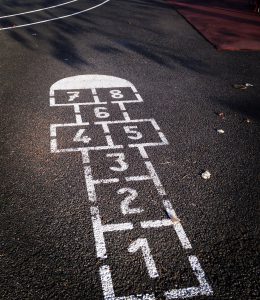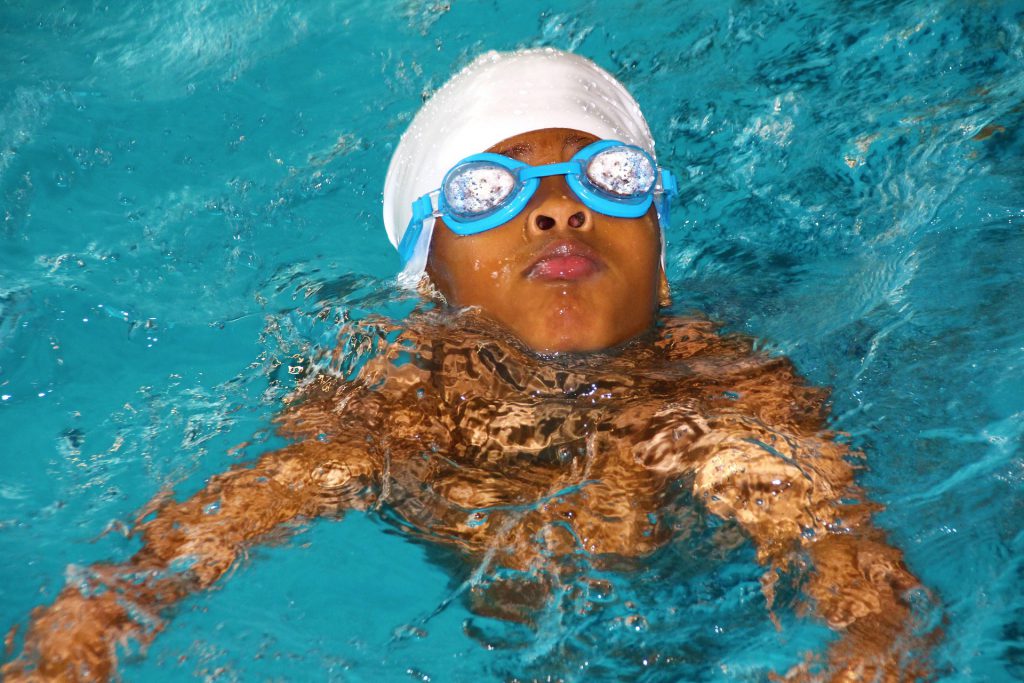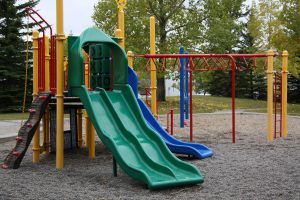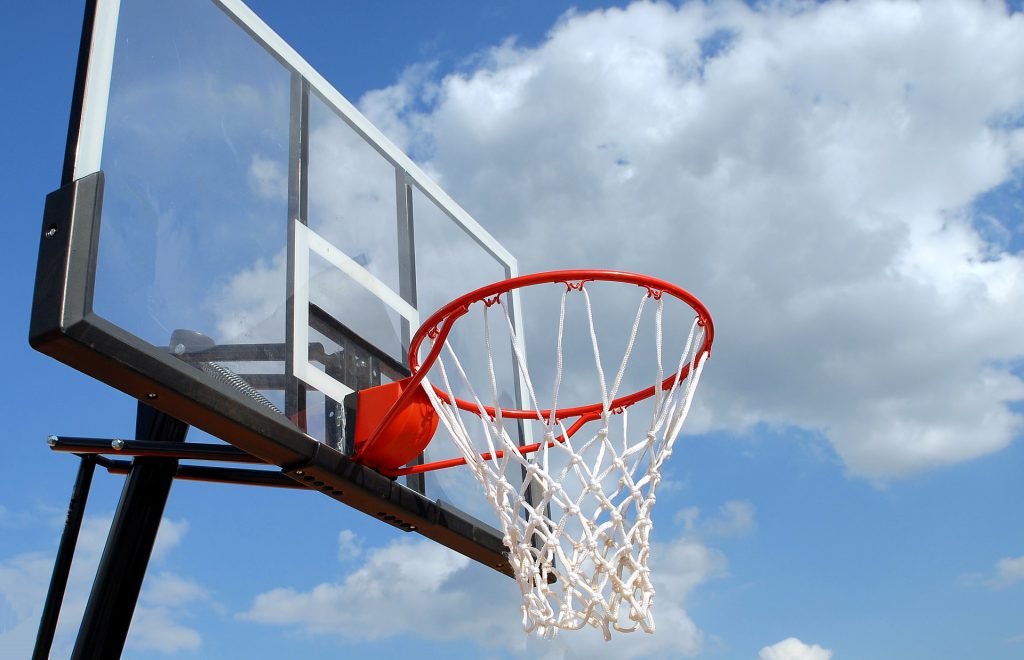Hopscotch

Hopscotch is a children’s game that has lasted through the generations–and for good reason! No equipment is required and children enjoy making their own hopscotch spaces using sidewalk chalk. It’s also a great game for preschoolers to practice their motor skills by learning to control their movement while hopping on one foot.
To play hopscotch, draw a diagram like the one above using sidewalk chalk on asphalt or concrete. You can also play inside and make the diagram with tape. This is a great way to let your children get creative with making the diagram! The player going first should toss a small rock, small bean bag, or other marker onto the first space on the diagram. Whichever spot the marker lands on is the space they need to hop to. Hop on single squares with one foot and side-by-side squares with one foot in each square. Once you reach the marker, pick it up (still on one foot!) and toss it to the next space to continue. After the first player is finished, subsequent players may take their turns.
In addition to the classic way to play hopscotch, there are other ways to play. For more detailed instructions and hopscotch variations, visit http://www.parents.com/fun/activities/hopscotch/. See if you and your children can think of your own way to play!
How do your children play hopscotch?
Plan a Family Outing

What’s the last activity you and your family did outside of the home? It’s easy to suffer from “cabin fever” after being at home for awhile. When you and your family are feeling restless and need time out of your home, plan an active family outing!
Plan family events that involve physical activities (e.g. hiking, horseback riding, camping, water sports) to help your children get the recommended 60 minutes of daily activity. Hiking and camping are great ways to experience nature while Moving More. Water sports may be unfamiliar to you and your family, but there are many to choose from. If you have access to a net, give water volleyball a shot. You can even try activities like “Sharks and Minnows,” water aerobics, and diving. There’s also water polo and its more child-friendly version called “Splashball.” Finding horseback riding lessons near you can be a great opportunity to teach your children about farm animals and the importance of farmers growing our food!
For more ideas on how to be active as a family, both in and out of the home, visit https://www.youtube.com/watch?v=Zw7x-V8yMwg.
This weekend, try an activity you haven’t before. Share what you did and how your family liked it! Can you think of other family activities?
Ultimate Frisbee

Organized sports are great physical activities for children to learn sportsmanship, treating others with respect, and honesty. Ultimate frisbee may be a new sport to you and your family, but it can be a fun, unique game to play. It’s played like soccer and football, except instead of playing with a ball you toss a frisbee. Oftentimes, parks will have open grassy areas you can play on. You may even find a soccer field with painted boundaries you can use. You can also play more casually in your yard.
Throwing a frisbee isn’t hard once you practice it a bit. Hold the frisbee in your dominant hand with your thumb on top of the disc and your pointer and middle fingers on the underside. Twisting the opposite way (if you’re right-handed, move your body to your left), bend your elbow and then untwist and release the frisbee as you extend your arm out. Each team scores by completing a pass in the other team’s end zone. Don’t let the frisbee hit the ground or run with the frisbee. If you’re holding the frisbee, you have 10 seconds to pass it–just remember not to run with the frisbee!
Make sure the ground is free of debris and other safety hazards before you play. Also, take the time to stretch first since ultimate frisbee involves running and throwing! To learn official rules, technique, and “the Spirit of the Game,” visit http://www.usaultimate.org/index.html.
Start practicing your frisbee toss to get started!
Child Development

Recent research shows that our brains don’t finish developing until around age 25.¹ Children’s emotional, physical, mental, and social skills develop tremendously as they get older. Many developmental skills can be improved through physical activity. Find your child’s age below and try the corresponding activities with your child. These activities can help your child grow and develop while also getting their 60 minutes of daily physical activity!
6 to 18 months (Infants)
- Hiding games can help improve infants’ working memory. Hide a toy under a small cloth or blanket and once they can find it, try hiding it elsewhere and show them that it’s not under the cloth. You may be able to play hide-and-seek with older infants, or try hiding an object without them seeing and have them find it.
- Take turns doing an activity your older infant is interested in, such as picking up toys and cleaning. Children at this age often imitate what they see you do, so you can encourage them to participate in activities such as these that get them moving and work their muscles.
- Simple hand movements help infants develop self-control and memory. Try movements such as “Itsy Bitsy Spider.”
18 to 36 months (Toddlers)
- Use materials like balance beams, balls, ramp inclines, etc. to help toddlers learn new physical skills. You can even create an obstacle course with objects such as these!
- Older toddlers can try imitation games like “Follow the Leader.” As the leader, you can have your children do simple physical activities such as walking, running and jumping.
- Games like “Freeze Dance,” “Popcorn,” and “Ring Around the Rosie” are active and promote active inhibition.
- Songs with movements such as “The Hokey Pokey,” “I’m a Little Teapot,” and “Head, Shoulders, Knees, and Toes” improve children’s working memory as the songs guide their actions.
- Simple hand movements help toddlers develop self-control and memory. Try movements such as “Itsy Bitsy Spider.”
3 to 5 years old (Preschoolers)
- Encourage children to tell stories using their imagination and use physical movements to act out the story.
- Use materials like climbing structures, balance beams, see saws, etc. to help preschoolers learn new physical skills. You can even create an obstacle course with objects such as these!
- Quieter activities such as yoga and using a balance beam require children to focus their attention.
- Games like “Freeze Dance,” “Popcorn,” and “Ring Around the Rosie” are active and promote active inhibition.
5 to 7 years old (Younger School-Aged Children)
- Games like “Freeze Dance,” “Musical Chairs,” “Red Light, Green Light,” and “Duck, Duck, Goose,” and “Simon Says” are active and promote active inhibition. Also, “Mother May I?” and “What Time Is It, Mr. Fox?” promote mental tracking and challenge working memory.
- Four square, dodgeball, and tetherball help children learn rule-following, self-control, and fast decision-making.
- Children can start getting involved in structured physical activity such as organized sports. Sports can improve coordination and attention skills. Yoga and Tae Kwon Do are especially helpful in developing attention and control.
- Playing “I Spy” while walking incorporates physical activity and requires children to think and pay attention.
7 to 12 years old (Older School-Aged Children)
- Dancing can help children with self-monitoring, memory, and attention.
- Children can start getting involved in structured physical activity such as organized sports. Sports can improve coordination and attention skills. Yoga and Tae Kwon Do are especially helpful in developing attention and control.
- Jump rope and its related games (double Dutch, Chinese jump rope, etc.) are great aerobic exercise that also help develop working memory and attention.
- Hiding and tag games are active and promote inhibition and fast reaction times.
Adolescents (Teenagers)
- Adolescents may prefer competitive sports to games and activities they used to play. Organized sports help teens make quick decisions and respond to play while providing a great aerobic workout.
- Yoga and meditation promote a longer attention span while improving physical flexibility and reducing stress.
To learn more activities to help your child grow, visit http://developingchild.harvard.edu/wp-content/uploads/2015/05/Enhancing-and-Practicing-Executive-Function-Skills-with-Children-from-Infancy-to-Adolescence-1.pdf.
Can you think of other activities that challenge both the mind and body?
References
Basketball

Basketball is a heart-pumping sport you can play year-round, whether on an indoor or outdoor court. Parks, schools, faith-based communities, and other locations near you may have a basketball court. Call in advance to see if the court has an open-use policy. Children who enjoy competitive play may love to give basketball a try! Younger or less competitive children can also participate in basketball–try teaching them basic skills (dribbling, passing, etc.) they can practice outside of formal gameplay. Also, you can see if your children’s friends and other children in your neighborhood would like to join to get a game going.
Before children can play a structured basketball game, they should learn the fundamentals of basketball. Here are a few to get them started:
- Dribbling: Dribbling is bouncing the ball on the court and it’s how players move with the basketball across the court. Rather than using the palm to dribble, use fingertips. Keep your head high and avoid letting the ball bounce above your waist.
- Passing: The three main passes are the bounce pass, the chest pass, and the overhead pass. The bounce and chest pass are done with the same motion, except the ball is thrown from the chest for the chest pass, and for the bounce pass the ball bounces on the court toward the other player. The overhead pass is better from a longer distance and the player should hold the ball with both hands directly overhead and throw toward the receiving player.
- Shooting: Stand with legs shoulder-width apart with feet pointed generally toward the basket. Place your dominant (“shooting” hand) in the center of the ball and your non-shotting hand on the side for balance. Holding the ball in front of you with your shooting elbow bent under the ball, extend your arm in a straight line toward the rim and release the ball on the way up. As you shoot, the non-shooting hand should come off the ball and not influence the shot. After the ball leaves your hand, you should hold your follow-through position until the ball reaches the rim (wrists relaxed, arms in the same position as when you shot the ball, fingers pointed toward the rim).
Click here for detailed rules and instructions!
Children who can swim can even play a modified game of basketball in the pool! Use a basketball hoop made for the pool or closed object like a hula hoop to shoot the basketball into. Just make sure children have plenty of room and stay aware of other swimmers if it’s a public pool. Like any pool activity, children should be supervised at all times.
To find a basketball court near you, visit https://www.courtsoftheworld.com/courts.
Where will your children play basketball this week?